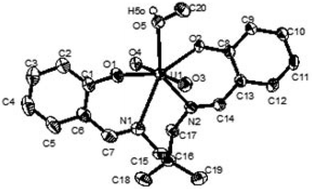Novel uranyl(vi) complexes incorporating propylene-bridged salen-type N2O2-ligands: a structural and computational approach†
Abstract
The synthesis of the tetradentate dianionic ligand, H2L (2,2′-(1E,1′E)-(2,2-dimethylpropane-1,3-dyl)bis(azanylylidene)bis(methanylylidene)diphenol), from 2,2-dimethyl-1,3-diaminopropane and its reaction with UO2(CH3COO)2·2H2O in a 1 : 1 molar ratio in methanol to produce the complex [UO2(L)(CH3OH)] are reported. The isolated compounds have been characterized by elemental analysis, ionization mass spectrometry (ESI-MS), UV/Vis, FT-IR, 1H- and 13C-NMR, DEPT-135 spectroscopy, TGA and single-crystal X-ray diffraction. As shown by X-ray crystallography, the coordination geometry around the uranium centre is distorted pentagonal bipyramidal with two imine nitrogen atoms, two phenolic oxygen atoms and one methanol O atom occupying equatorial sites, together with two axial oxo groups. To obtain insights into the structure and spectral properties of the studied complex, density functional theory (DFT) and time dependent density functional theory (TD-DFT) calculations have been carried out. The computed results show that LUMO of the complex is featured with uranium f orbital character. TD-DFT results indicate that the complex displays two intense bands and one weak charge transfer band. The charge transfer band is primarily due to HOMO → LUMO (53%). Two intense bands have main contributions from HOMO−2 → LUMO (81%) and HOMO−3 → LUMO (77%) transitions, respectively. TD-DFT results indicate that the complex displays the charge transfer band primarily due to HOMO → LUMO (53%) and other two charge transfer bands have main contributions from HOMO−2 → LUMO (81%), HOMO−3 → LUMO (77%) transitions, respectively. NBO analysis reveals that the ground state of the complex is mainly stabilized by n→n* interaction. EDA analysis reveals that the interaction existing between the ligand and other parts of the complex is mainly electrostatic in nature.


 Please wait while we load your content...
Please wait while we load your content...